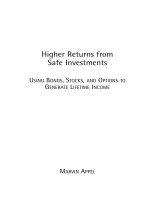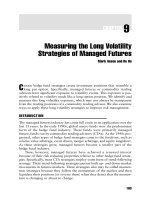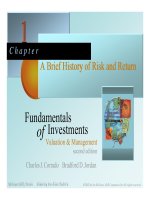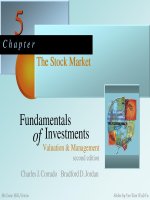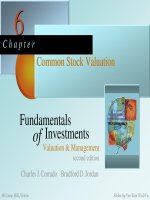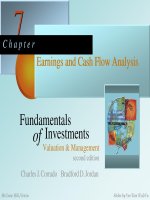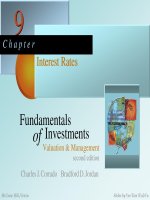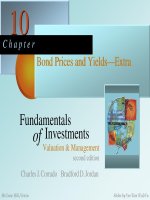Charles J. Corrado_Fundamentals of Investments - Chapter 9 ppt
Bạn đang xem bản rút gọn của tài liệu. Xem và tải ngay bản đầy đủ của tài liệu tại đây (695.22 KB, 68 trang )
CHAPTER 9
Interest Rates
One truism of commerce holds that time is money, but how much time is how
much money? Interest is a rental rate for money, and an interest rate tells
us how much money for how much time. But there are many interest rates,
each corresponding to a particular money market. Interest rates state money
prices in each of these markets
This chapter is the first dealing specifically with interest-bearing assets. As we discussed in
Chapter 3, there are two basic types of interest-bearing assets, money market instruments and fixed
income securities. For both types of assets, interest rates are a key determinant of asset values.
Furthermore, since there are well over $20 trillion of interest-bearing assets outstanding, interest rates
play a pivotal role in financial markets and the economy.
. Because interest rates are one of the most closely watched financial market indicators, we
devote this entire chapter to them. We first discuss the many different interest rates that are
commonly reported in the financial press, along with some of the different ways interest rates are
calculated and quoted. We then go on to describe the basic determinants and separable components
of interest rates.
2 Chapter 9
Figure 9.1 about here.
9.1 Interest Rate History and Money Market Rates
Recall from Chapter 3 that money market instruments are debt obligations that have a
maturity of less than one year at the time they are originally issued. Each business day, the Wall Street
Journal publishes a list of current interest rates for several categories of money market securities in
its “MONEY RATES” report. We will discuss each of these interest rates and the securities they
represent immediately below. First,, however, we take a quick look at the history of interest rates.
Interest Rate History
In Chapter 1, we saw how looking back at the history of returns on various types of
investments gave us a useful perspective on rates of return. Similar insights are available from interest
rate history. For example, at midyear 1997, short-term interest rates were about 5 percent and long-
term rates were about 7 percent. We might ask, “Are these rates unusually high or low?” To find out,
we examine Figure 9.1 which graphically illustrates almost 200 years of interest rates in the United
States.
Two interest rates are plotted in Figure 9.1, one for bills and one for bonds. Both rates are
based on U.S. Treasury securities, or close substitutes. We discuss bills and bonds in detail in this
chapter and the next chapter. For now, it is enough to know that bills are short-term and bonds are
long-term, so what is plotted in Figure 9.1 are short- and long-term interest rates.
Probably the most striking feature in Figure 9.1 is the fact that the highest interest rates in
U.S. history occurred in the not-too-distant past. Rates began rising sharply in the 1970s, and then
Interest Rates 3
peaked at extraordinary levels in the early 1980s. They have generally declined since then. The other
striking aspect of U.S. interest rate history is the very low short-term interest rates that prevailed from
the 1930s to the 1960s. This was the result, in large part, of deliberate actions by the Federal Reserve
Board to keep short-term rates low - a policy that ultimately proved unsustainable and even
disastrous. Much was learned by the experience, however, and now the Fed is more concerned with
controlling inflation.
With long-term rates close to 6 percent as this chapter is written, many market observers have
commented that these interest rate levels are extraordinarily low. Based on the history of interest rates
illustrated in Figure 9.1, however, 6 percent may be low relative to the last 25 years, but it is not at
all low compared to rates during the 170-year period from 1800 to 1970. Indeed, long-term rates
would have to fall to 4 percent or lower to be considered low by historical standards (but don’t hold
your breath).
(marg. def. prime rate The basic interest rate on short-term loans that the largest
commercial banks charge to their most creditworthy corporate customers.)
(marg. def. bellwether One that serves as a leader or as a leading indicator of future
trends, e.g., interest rates as a bellwether of inflation.)
Money Market Rates
Figure 9.2 reproduces a Wall Street Journal “MONEY RATES” report of interest rates for
the most important money market instruments. A commonly quoted interest rate is the prime rate.
The prime rate is a key short-term interest rate since it is the basic interest rate that large commercial
banks charge on short-term loans to their most creditworthy corporate customers. The prime rate is
well-known as a bellwether rate of bank lending to business.
4 Chapter 9
Figure 9.2 about here.
Loan rates to corporations with less than the highest credit rating are often quoted as the
prime rate plus a premium, where the premium depends on the credit quality of the borrower. For
example, a medium-sized corporation with a good credit rating might be charged the prime rate plus
1.5 percent for a short-term bank loan. Besides a prime rate for the United States, the “Money Rates”
report also lists foreign prime rates for Canada, Germany, Japan, Switzerland, and Great Britain.
(marg. def. Federal funds rate Interest rate that banks charge each other for
overnight loans of $1 million or more.)
The Federal funds rate (or just “Fed funds”) is a fundamental interest rate for commercial
bank activity. The Fed funds rate is the interest rate that banks charge each other for overnight loans
of $1 million or more. This interbank rate is set by continuous bidding among banks, where banks
wishing to lend funds quote “offer rates” (rates at which they are willing to lend), and banks wishing
to borrow funds quote “bid rates” (rates they are willing to pay). Notice that four different rates are
stated: high is the highest rate offered and low is the lowest rate bid during a day's trading; near
closing bid is a bid rate to borrow and near closing offered is an offered rate to lend near the end of
the day's trading.
(marg. def. discount rate The interest rate that the Fed offers to commercial banks
for overnight reserve loans.)
The Federal Reserve's discount rate is another pivotal interest rate for commercial banks. The
discount rate is the interest rate that the Fed offers to commercial banks for overnight reserve loans.
You might recall from your Money and Banking class that banks are required to maintain reserves
equal to some fraction of their deposit liabilities. When a bank cannot supply sufficient reserves from
Interest Rates 5
internal sources, it must borrow reserves from other banks through the Federal funds market.
Therefore, the Fed discount rate and the Fed funds rate are closely linked. The Fed funds rate is
normally slightly higher than the Federal Reserve's discount rate.
The Federal Reserve Bank is the central bank of the United States. It is charged with the
responsibility of managing interest rates and the money supply to control inflation and promote stable
economic growth. The discount rate is a basic tool of monetary policy for the Federal Reserve Bank.
An announced change in the discount rate is often interpreted as a signal of the Federal Reserve's
intentions regarding future monetary policy. For example, by increasing the discount rate the Federal
Reserve may be signaling that it intends to pursue a tight-money policy, most likely to control
budding inflationary pressures. Similarly, by decreasing the discount rate the Federal Reserve may be
signaling an intent to pursue a loose-money policy to stimulate economic activity. Of course, many
times a discount rate change is simply a case of the Federal Reserve catching up to financial markets’
conditions rather than leading them. Indeed, the Federal Reserve often acts like the lead goose, who
upon looking back sees the flock heading in another direction, then quickly flies over to resume its
position as “leader” of the flock.
(marg. def. call money rate The interest rate brokerage firms pay for call money
loans, which are bank loans to brokerage firms. This rate is used as the basis for
customer rates on margin loans.)
The next interest rate reported is the call money rate, or simply the call rate. “Call money”
refers to loans from banks to security brokerage firms, and the call rate is the interest rate that
brokerage firms pay on call money loans. As we discussed in Chapter 2, brokers use funds raised
through call money loans to make margin loans to customers to finance leveraged stock and bond
purchases. The call money rate is the basic rate that brokers use to set interest rates on customer call
6 Chapter 9
money loans. Brokers typically charge their customers the call money rate plus a premium, where the
broker and the customer may negotiate the premium. For example, a broker may charge a customer
the basic call money rate plus 1 percent for a margin loan to purchase common stock.
(marg. def. commercial paper Short-term, unsecured debt issued by the largest
corporations.)
Commercial paper is short-term, unsecured debt issued by the largest corporations. The
commercial paper market is dominated by financial corporations, such as banks and insurance
companies, or financial subsidiaries of large corporations. As shown in Figure 9.2, a leading
commercial paper rate is the rate that General Electric Capital Corporation (the finance arm of
General Electric) pays on short-term debt issues. This commercial paper rate is a benchmark for this
market because General Electric Capital is one of the largest single issuers of commercial paper. Most
other corporations issuing commercial paper will pay a slightly higher interest rate than this
benchmark rate. Commercial paper is a popular investment vehicle for portfolio managers and
corporate treasurers with excess funds on hand that they wish to invest on a short-term basis.
(marg. def. certificate of deposit (CD) Large denomination deposits of $100,000 or
more at commercial banks for a specified term.
Certificates of deposit, or CDs, represent large-denomination deposits of $100,000 or more
at commercial banks for a specified term. The interest rate paid on CDs usually varies according to
the term of the deposit. For example, a one-year certificate of deposit may pay a higher interest rate
than a six-month deposit, which in turn may pay a higher interest rate than a three-month deposit.
Large-denomination certificates of deposit are generally negotiable instruments, meaning that
they can be bought and sold among investors. Consequently, they are often called negotiable
certificates of deposits, or negotiable CDs. Negotiable CDs can be bought and sold through a broker.
Interest Rates 7
The large-denomination CDs described here should not be confused with the small-denomination CDs
that banks offer retail customers. These small-denomination CDs are simply bank time deposits. They
normally pay a lower interest rate than large-denomination CDs and are not negotiable instruments.
(marg. def. banker’s acceptance A postdated check on which a bank has guaranteed
payment; commonly used to finance international trade transactions.)
A banker’s acceptance is essentially a postdated check upon which a commercial bank has
guaranteed payment. Banker’s acceptances are normally used to finance international trade
transactions. For example, as an importer you wish to purchase computer components from a
company in Singapore and to pay for the goods three months after delivery, so you write a postdated
check. You and the exporter agree, however, that once the goods are shipped, your bank will
guarantee payment on the date specified on the check.
After your goods are shipped, the exporter presents the relevant documentation, and, if all is
in order, your bank stamps the word ACCEPTED on your check. At this point your bank has created
an acceptance, which means it has promised to pay the acceptance's face value (the amount of the
check) at maturity (the date on the check). The exporter can then hold on to the acceptance or sell
it in the money market. The banker’s acceptance rate published in “Money Rates” is the interest rate
for acceptances issued by the largest commercial banks.
(marg. def. London Eurodollars Certificates of deposit denominated in U.S. dollars
at commercial banks in London.)
London Eurodollars are certificates of deposit denominated in U.S. dollars at commercial
banks in London. Eurodollar rates are interest rates paid for large-denomination deposits. Eurodollar
CDs are negotiable and are traded in a large, very active Eurodollars money market. The “Money
8 Chapter 9
Rates” report lists Eurodollar rates for various maturities obtained from transactions occurring late
in the day.
(marg. def. London Interbank Offered Rate (LIBOR) Interest rate that
international banks pay one another for overnight Eurodollar loans.)
The London Interbank Offered Rate (LIBOR) is the interest rate offered by London
commercial banks for dollar deposits from other banks. The LIBOR rate is perhaps the most
frequently cited rate used to represent the London money market. Bank lending rates are often stated
as LIBOR plus a premium, where the premium is negotiated between the bank and its customer. For
example, a corporation may be quoted a loan rate from a London bank at LIBOR plus 2 percent.
(marg. def. U.S. Treasury bill (T-bill) A short-term U.S. government debt
instrument issued by the U.S. Treasury)
U.S. Treasury bills, or just T-bills, represent short-term U.S. government debt issued through
the U.S. Treasury. The Treasury bill market is the largest market for short-term debt securities in the
world. As such, the Treasury bill market leads all other credit markets in determining the general level
of short-term interest rates. “Money Rates” reports Treasury bill interest rates set in the most recent
weekly Treasury bill auction. Interest rates determined at each Treasury bill auction are closely
watched by professional money managers throughout the world.
The Federal Home Loan Mortgage Corporation (FHLMC), commonly called “Freddie Mac,”
and the Federal National Mortgage Association (FNMA), commonly called “Fannie Mae,” are
government-sponsored agencies that purchase large blocks of home mortgages and combine them
into mortgage pools, where each pool may represent several tens of millions of dollars of home
mortgages. We will discuss mortgage pools in depth in Chapter 13. The interest rates reported in
“Money Rates” are an indicator of rates on newly created home mortgages. Since home mortgages
Interest Rates 9
Figures 9.3 about here.
are long-term obligations, these are not actually money market rates. However, with several trillion
dollars of mortgages outstanding, the mortgage market has a considerable influence on money market
activity.
The Merrill Lynch Ready Assets Trust is a money market fund for customer accounts with
the brokerage firm of Merrill Lynch. Recall from Chapter 4 that money market funds are mutual funds
that invest in money market instruments. The interest rate reported in the “Money Rates” report is
an average of interest rates paid on fund accounts over the previous month.
In its daily “CREDIT MARKETS” column, the Wall Street Journal reports the most recent
developments in the various markets for interest-bearing assets. A sample “Credit Markets” report
is shown later in an Investment Updates box. A recurring feature of this section are charts of
information regarding current interest rates and interest rates over the most recent several-month
period. Figure 9.3 presents sample chart boxes from the “Credit Markets” column.
The “Bond Yields” chart in Figure 9.3A is published each Monday. It graphs recent yields
for AA-rated (medium high credit quality) utility company bonds, long-term Treasury bonds, and
municipal bonds The “Key Interest Rates” chart in Figure 9.3B is published each Tuesday. This
chart lists current interest rates for the major money market instruments along with interest rates for
U.S. Treasury notes and bonds (which we discuss in a subsequent section). The “Short-Term
Interest Rates” chart in Figure 9.3C is published each Thursday. It displays weekly averages of the
Federal funds rate, the three-month commercial paper rate, and the three-month Treasury bill rate
over the most recent several month’s period. The “Consumer Savings Rates” box in Figure 9.3D
10 Chapter 9
is also published each Thursday. This box lists prevailing interest rates for money market deposits,
bank certificates of deposits, and U.S. savings bonds.
CHECK THIS
9.1a Which money market interest rates are most important to commercial banks?
9.1b Which money market interest rates are most important to nonbank corporations?
(marg. def. pure discount security An interest-bearing asset that makes a single
payment of face value at maturity with no payments before maturity.)
9.2 Money Market Prices and Rates
Money market securities typically make a single payment of face value at maturity and make
no payments before maturity. Such securities are called pure discount securities because they sell
at a discount relative to their face value. In this section, we discuss the relationship between the price
of a money market instrument and the interest rate quoted on it.
One of the things you will notice in this section is that there are several different ways market
participants quote interest rates. This presents a problem when we wish to compare rates on different
investments. But before we can do this, we must put them on a common footing.
After going through the various interest rate conventions and conversions needed to compare
them, you might wonder why everybody doesn’t just agree to compute interest rates and prices in
some uniform way. Well perhaps they should, but they definitely do not. As a result, we must review
some of the various procedures actually used in money markets. We hope you come to recognize that
the calculations are neither mysterious nor even especially difficult, although they are rooted in
Interest Rates 11
Current price Face value × 1
Days to maturity
360
× Discount yield
[1]
centuries-old procedures and may sometimes be tedious. However, given the billions of dollars of
securities traded every day based on these numbers, it is important to understand them.
One other thing to notice is that the word “yield” appears frequently. For now, you can take
it as given that the yield on an interest-bearing asset is simply a measure of the interest rate being
offered by the asset. We will discuss the topic of yields in greater detail in the next chapter.
(marg. def. bank discount basis A method for quoting interest rates on money
market instruments.)
Bank Discount Rate Quotes
Interest rates for some key money market securities, including Treasury bills and banker’s
acceptances, are quoted on a bank discount basis, or simply a discount basis. An interest rate quoted
on a discount basis is often called a discount yield. If we are given an interest rate quoted on a bank
discount basis for a particular money market instrument, then we calculate the price of that instrument
as follows:
The term “discount yield ” here simply refers to the quoted interest rate. It should not be confused
with the Federal Reserve’s discount rate discussed earlier.
To give an example, suppose a banker’s acceptance has a face value of $1 million that will
be paid in 90 days. If the interest rate, quoted on a discount basis, is 5 percent, what is the current
price of the acceptance?
12 Chapter 9
$987,500 $1,000,000 ×
1
90
360
× .05
$949,305.56 $1,000,000 ×
1
365
360
× .05
As the following calculation shows, a discount yield of 5 percent and maturity of 90 days
gives a current price of $987,500:
The difference between the face value of $1 million and the price of $987,500 is $12,500 and is called
the “discount.” This discount is the interest earned over the 90-day period to when the acceptance
matures.
Notice that the formula used to calculate the acceptance price assumes a 360-day business
year. This practice dates back to a time when calculations were performed manually. Assuming a 360-
day business year, with exactly four 90-day quarters rather than a true 365-day calendar year, made
manual discount calculations simpler and less subject to error. Consequently, if $1 million is
discounted over a full calendar year of 365 days using a bank discount yield of 5 percent and an
assumed 360-day business year, the resulting price of $949,305.56 is calculated as follows:
Example 9.1: Money Market Prices The rate on a particular money market instrument, quoted on
a discount basis, is 6 percent. The instrument has a face value of $100,000 and will mature in 71 days.
What is its price? What if it had 51 days to maturity?
Interest Rates 13
Current price Face value ×
1
Days to maturity
360
× Discount rate
$98,816.67 $100,000 ×
1
71
360
× .06
Figure 9.4 about here.
Using the bank discount basis formula, we have:
Check for yourself that the price in the second case of a 51-day maturity is $99,150.
Treasury Bill Quotes
The Wall Street Journal reports current interest rates on U.S. Treasury bills each business
day. Figure 9.4 reproduces a “TREASURY BILLS” interest rate report. The maturity of each bill
issue is stated in month-day-year format, followed by the number of days remaining until the bill
matures.
The two columns following the days to maturity give the bid and asked discounts for each bill issue.
The bid discount is used by Treasury bill dealers to state what they are willing to pay for a Treasury
bill, and the asked discount is used to state what price a dealer will accept to sell a Treasury bill. The
next column shows the change in the asked discount from the previous day.
For example, consider a bill issue with 154 days to maturity, with a bid discount rate of
5.44 percent and an asked discount rate of 5.42 percent. For a $1 million face value Treasury bill, the
14 Chapter 9
Bid price $976,728.89 $1,000,000 ×
1
154
360
× .0544
Asked price $4,786,500 $5,000,000 ×
1
280
360
× .0549
corresponding bid and asked prices can be calculated by using the discounts shown along with our
bank discount basis pricing formula. For example, the bid price would be
Check that the ask price would be $976,814.44.
Example 9.2: T-Bill Prices Suppose you wanted to buy a T-bill with 280 days to maturity and a face
value of $5,000,000. How much would you have to pay if the asked discount is 5.49 percent?
Since you are buying, you must pay the asked price. To calculate the asked price, we use the
asked discount in the bank discount basis formula:
Calculate a bid price for this T-bill assuming a bid discount of 5.54 percent. Notice that the asked is
higher than the bid price even though the asked discount is lower than the bid discount. The reason
is that a bigger discount produces a lower price.
The last column in Figure 9.4 lists the asked yield (“Ask Yld.”) for each Treasury bill issue.
It is important to realize that the asked yield is not quoted on a discount basis. Instead, it is a “bond
equivalent yield.” Unlike a discount rate, a bond equivalent yield assumes a 365-day calendar year.
Bond equivalent yields are principally used to compare yields on Treasury bills with yields on other
money market instruments as well as Treasury bonds and other bonds (we discuss these long-term
yields in the next chapter).
Interest Rates 15
Bond equivalent yield
365 × Discount yield
360 Days to maturity × Discount yield
[2]
3.315%
365 × .0322
360 170 × .0322
5.101%
365 × .05
360 45 × .05
Bank Discount Yields versus Bond Equivalent Yields
A bank discount yield is converted to a bond equivalent yield using the following formula:
This conversion formula is correct for maturities of six months or less. Calculation of bond equivalent
yields for maturities greater than six months is more complicated, and we will not discuss it here (This
is why many investments texts cut off their tables of T-bill rates at 180 days!).
For example, suppose the asked discount rate on a T-bill with 170 days to maturity is
3.22 percent. What is the bond equivalent yield? Plugging into the conversion formula, a 3.22 percent
discount is converted into a bond equivalent yield as follows:
The bond equivalent yield is thus 3.315 percent.
Example 9.3: Bond Equivalent Yields Suppose a T-bill has 45 days to maturity and an asked discount
of 5 percent. What is the bond equivalent yield?
Using the bond equivalent yield conversion formula, we have
The bond equivalent yield is thus 5.101 percent.
One common cause of confusion about bond equivalent yield calculations is the way that leap
years are handled. The rule is, we must use 366 days if February 29 occurs within the next 12 months.
For example, 2000 will be a leap year. So, beginning on March 1, 1999, we must use 366 days in the
formula above. Then beginning on March 1, 2000, we must revert back to using 365 days.
16 Chapter 9
5.60%
366 × .0541
360 119 × .0541
Bill price
Face value
1 Bond equivalent yield × Days to maturity/365
[3]
$984,795
$1,000,000
1 .03315 × 170 / 365
Example 9.4: Back to the Future - Leap Year Bond Equivalent Yields Calculate the asked yield (bond
equivalent yield) for a T-bill price quoted in December 1999 with 119 days to maturity and an asked
discount of 5.41 percent.
Since the 12 month period following the date of the price quote includes February 29, we
must use 366 days. Plugging this into the conversion formula, we get
This 5.60 percent is the ask yield stated as a bond equivalent yield.
We can calculate a Treasury bill asked price using the asked yield, which is a bond equivalent
yield, as follows:
For example, just above we calculated the 3.315 percent bond equivalent yield on a T-bill with 170
days to maturity and a 3.22 percent asked discount rate. If we calculate its price using this bond
equivalent yield, we get:
Check that, ignoring a small rounding error, you get the same price using the bank discount formula.
One other potentially confusing issue can come up. If you examine the days to maturity
reported by the Journal, you will notice that they seem to be consistently off by a day or two. There
are two reasons for this. First, quotes published in the Wall Street Journal on, say, a Wednesday refer
to T-bill prices and rates quoted on Tuesday, the day before. Second, published quoted prices assume
“skip-day” settlement, which means the quoted prices are for delivery and payment in two business
days. Days to maturity published in the Wall Street Journal are measured relative to this “skip-
Interest Rates 17
settlement day.” But just in case you’re not completely confused yet, T-Bill settlement no longer
operates on a skip-day basis. Rather, T-Bill settlement actually operates on a “next-day” basis,
meaning that prices are quoted for delivery the following business day. So why does the Journal
continue to use skip-day settlement? The answer is simply tradition.
Bond Equivalent Yields, APRs, and EARs
Money market rates not quoted on a discount basis are generally quoted on a “simple” interest
basis. Simple interest rates are calculated just like the annual percentage rate (APR) on a consumer
loan. So, for the most part, money market rates are either bank discount rates or APRs. For example,
CD rates are APRs.
In fact, the bond equivalent yield on a T-bill with less than six months to maturity is also an
APR. As a result, like any APR, it understates the true interest rate, which is usually called the
effective annual rate, or EAR. In the context of the money market, EARs are sometimes referred to
as effective annual yields, effective yields, or annualized yields. Whatever it is called, to find out what
a T-bill, or any other money market instrument, is really going to pay you, yet another conversion
is needed. We will get to the needed conversion in a moment.
First, however, recall that an APR is equal to the interest rate per period multiplied by the
number of periods in a year. For example, if the rate on a car loan is 1 percent per month, then the
APR is 1% × 12 = 12%. In general, if we let m be the number of periods in a year, an APR is
converted to an EAR as follows:
18 Chapter 9
1 EAR
1
APR
m
m
[4]
1 EAR 1
.12
12
12
1.01
12
1.126825
EAR 12.6825%
1 EAR
1
.18
12
12
1.015
12
1.1956
EAR 19.56%
For example, on our 12 percent APR car loan, the EAR can be determined by
Thus, the rate on the car loan is really 12.6825 percent per year.
Example 9.5: APRs and EARs A typical credit card may quote an APR of 18 percent. On closer
inspection, you will find that the rate is actually 1.5 percent per month. What annual interest rate are
you really paying on such a credit card?
With 12 periods in a year, an APR of 18 percent is converted to an EAR as follows:
Thus the rate on this credit card is really 19.56 percent per year.
Now, to see that the bond equivalent yield on a T-bill is just an APR, we can first calculate
the price on the bill we considered earlier (3.22 percent asked discount, 170 days to maturity). Using
the bank discount formula, the asked price, for $1 million in face value, is
Interest Rates 19
Asked price $984,794.44 $1,000,000 ×
1
170
360
× .0322
1.544% $15,205.56 / $984,794.44
3.315% 2.147 × 1.544%
1 EAR
1
.03315
2.147
2.147
1.03344
EAR 3.344%
The discount is $15,205.56. Thus on this 170-day investment, you earn $15,205.56 in interest on an
investment of $984,794.44. On a percentage basis, you earned
In a 365-day year, there are 365/170 = 2.147 periods of 170-day length. So if we multiply what you
earned over the 170-day period by the number of 170-day periods in a year, we get
This is precisely the bond equivalent yield we calculated earlier.
Finally, for this T-bill we can calculate the EAR using this 3.315 percent:
In the end, we have three different rates for this simple T-bill. The last one, the EAR, finally tells us
what we really want to know: What are we actually going to earn?
20 Chapter 9
$99 $100 ×
1
60
360
× Discount yield
6.145%
365 × .06
360 60 × .06
1 EAR
1
.06145
6.0833
6.0833
1.06305
EAR 6.305%
Example 9.6: Discounts, APRs, and EARs A money market instrument with 60 days to maturity has
a quoted ask price of 99, meaning $99 per $100 face value. What are the banker’s discount yield, the
bond equivalent yield, and the effective annual return?
First, to get the discount yield, we have to use the bank discount formula and solve for the
discount yield:
With a little algebra, we see that the discount yield is 6 percent.
We convert this to a bond equivalent yield as follows:
The bond equivalent yield is thus 6.145 percent.
Finally, to get the EAR, note that there are 6.0833 sixty-day periods in a year, so
This example illustrates the general result that the discount rate is lower than the bond equivalent
yield, which in turn is less than the EAR.
CHECK THIS
9.2a What are the three different types of interest rate quotes that are important for money market
instruments?
9.2b How are T-bill rates quoted? How are CD rates quoted?
9.2c Of the three different types of interest rate quotes, which is the largest? Which is the smallest?
Which is the most relevant?
Interest Rates 21
Investment Update: Credit Markets
9.3 Rates and Yields on Fixed-Income Securities
Thus far we have focused on short-term interest rates, where “short-term” means one year
or less. Of course, these are not the only interest rates we are interested in, so we now begin to
discuss longer term rates by looking at fixed-income securities. To keep this discussion to a
manageable length, we defer the details of how some longer term rates are computed to Chapter 10.
Fixed-income securities include long-term debt contracts from a wide variety of issuers. The
largest single category of fixed-income securities is debt issued by the U.S. government. The second
largest category of fixed-income securities is mortgage debt issued to finance real estate purchases.
The two other large categories of fixed-income securities are debt issued by corporations and debt
issued by municipal governments. Each of these categories represents more than a trillion dollars of
outstanding debt. Corporate bonds are covered in detail in Chapter 11 and municipal government
bonds are covered in Chapter 12.
Because of its sheer size, the leading world market for debt securities is the market for U.S.
Treasury securities. Interest rates for U.S. Treasury debt are closely watched throughout the world,
and daily reports can be found in most major newspapers. The Wall Street Journal provides a daily
summary of activity in the U.S. Treasury market in its “CREDIT MARKETS” column, as seen in the
nearby Investment Updates box.
22 Chapter 9
(marg. def. Treasury yield curve A graph of Treasury yields plotted against
maturities.)
The Treasury Yield Curve
Every day, the “Credit Markets” column contains a graphical display of a current Treasury
yield curve, which is a plot of Treasury yields against maturities. Yields are measured along the
vertical axis and maturities are measured along the horizontal axis. The dark, thick line represents the
most current yield curve, while the background lines represent recent yield curves. Thus the
“Treasury Yield Curve” box illustrates both where Treasury interest rates are now and where they
were recently.
The Treasury yield curve is fundamental to bond market analysis because it represents the
interest rates that financial markets are charging to the world's largest debtor with the world's highest
credit rating—the U.S. government. In essence, the Treasury yield curve represents interest rates for
default-free lending across the maturity spectrum. As such, almost all other domestic interest rates
are determined with respect to U.S. Treasury interest rates.
Rates on Other Fixed-Income Investments
The “Yield Comparisons” table immediately below the Treasury yield curve in the box gives
interest rates based on bond market indexes constructed by the securities firm Merrill Lynch. Both
current interest rates and the highest and lowest interest rates over the previous 52-week period are
reported for a number of bond indexes. These bond market indexes provide yield information on
many different types of bonds. Since we will be discussing these in much more detail in the next
several chapters, we touch on them only briefly here.
Interest Rates 23
The first two indexes represent U.S. Treasury securities with 1-to-10 year maturities and
10-to-30 year maturities. The longest maturity securities issued by the Treasury are 30-year maturity
bonds. The next two indexes represent U.S. government agency debt with 1-to-10 year maturities,
and debt with more than 10 years to maturity. A variety of government agencies borrow money in
financial markets. The Tennessee Valley Authority (TVA) is an example.
In recent years, U.S. government agencies have issued debt with maturities as long as 50
years. U.S. government agency debt does not carry the same credit guarantee of U.S. Treasury debt,
and therefore interest rates on agency debt reflect a premium over interest rates on Treasury debt.
Also, agency securities are subject to state taxes, whereas Treasury securities are not.
The next four indexes represent debt issued by domestic corporations according to their
maturity and credit rating. Notice that corporate debt with a high credit quality pays a higher interest
rate than U.S. government agency debt, which in turn pays a higher interest rate than U.S. Treasury
debt. As expected, medium credit quality corporate debt pays a higher interest rate than high credit
quality corporate debt.
“Yankee bonds” are issued by foreign corporations for sale in the United States. These bonds
are denominated in U.S. dollars so investors do not have to worry that changing foreign currency
prices will affect debt values.
As we noted previously, the Federal Home Loan Mortgage Corporation (FHLMC), or
Freddie Mac, and the Federal National Mortgage Association (FNMA), or Fannie Mae, are
government-sponsored agencies that repackage home mortgages into mortgage pools where each
pool represents several tens of millions of dollars of home mortgages. A third agency, the
Government National Mortgage Association (GNMA), better known as “Ginnie Mae,” is also an
24 Chapter 9
active mortgage repackager. The interest rates reported for these agencies correspond to indexes
constructed from many mortgage pools.
“High-yield corporates” refers to corporate bonds with above-average default risk. These
bonds are usually avoided by conservative investors, but they may be attractive to investors who
understand and are willing to accept the risks involved. Because of their much higher credit risk, the
interest rates for these bonds are significantly higher than those for even medium quality corporate
bonds.
“New tax-exempts” are bonds issued by municipal governments. Coupon interest payments
on most municipal bonds are exempt from federal income taxes, and they are often exempt from state
income taxes as well. The tax-exempt interest rates reported in the “Yield Comparisons” table are
based on indexes for high-quality municipal bonds corresponding to 10-year maturity and 20-year
maturity general obligation bonds (GOs) and 30-year maturity revenue bonds.
General obligation bonds are secured by the general taxing power of the issuing municipality.
Revenue bonds are secured by revenues generated from specific projects, for example, toll roads,
airports, or user fees for services. As shown, because of their tax-exempt status, interest rates on
high-quality municipal bonds are lower than interest rates on comparable U.S. Treasury securities.
CHECK THIS
9.3a What is the yield curve? Why is it important?
9.3b Why are corporate bond yields higher than Treasury bond yields?
9.3c Why are municipal bond yields lower than Treasury bond yields?
Interest Rates 25
(marg. def. term structure of interest rates Relationship between time to maturity
and interest rates for default-free, pure discount instruments.)
9.4 The Term Structure of Interest Rates
The yield curve tells us the relationship between Treasury bond yields and time to maturity.
The term structure of interest rates (or just “term structure”) is a similar, but not identical,
relationship. Recall that a pure discount instrument has a single payment of face value at maturity with
no other payments until then. Treasury bonds are not pure discount instruments because they pay
coupons every six months. Pure discount instruments with more than a year to maturity are often
called “zero coupon bonds,” or just “zeroes,” because they are, in effect, bonds with a zero coupon
rate.
The term structure of interest rates is the relationship between time to maturity and interest
rates for default-free, pure discount instruments. So, the difference between the yield curve and the
term structure is that the yield curve is based on coupon bonds, whereas the term structure is based
on pure discount instruments. The term structure is sometimes called the “zero coupon yield curve”
to distinguish it from the Treasury yield curve.
